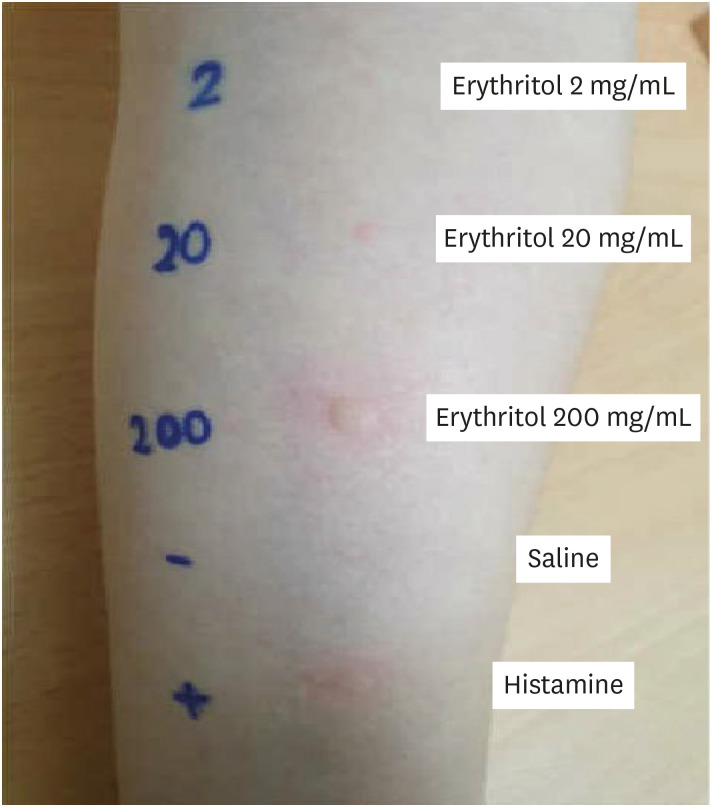J Korean Med Sci.
2022 Mar;37(10):e83. 10.3346/jkms.2022.37.e83.
The First Case of Erythritol-Induced Anaphylaxis in Korea
- Affiliations
-
- 1Division of Pulmonary, Allergy, and Critical Care Medicine, Department of Internal Medicine, Pusan National University Hospital, Busan, Korea
- 2Department of Internal Medicine, Pusan National University College of Medicine, Busan, Korea
- 3Biomedical Research Institute, Pusan National University Hospital, Busan, Korea
- KMID: 2526979
- DOI: http://doi.org/10.3346/jkms.2022.37.e83
Abstract
- Erythritol is a natural sugar alcohol found in some fruits and fermented foods, which is used as a dietary sweetener because it has few calories. Here, we describe a 36-year-old woman who experienced anaphylaxis upon ingestion of an erythritol-containing drink. She presented to the emergency department with dyspnea and angioedema after drinking a peachcontaining diet beverage. Her blood pressure dropped to 70/40 mmHg and the symptoms improved after administration of an antihistamine, glucocorticoid, and epinephrine. After 10 days, she drank another peach-containing diet beverage and experienced urticaria. No serumspecific immunoglobulin E findings were observed, including against peach components. A skin prick test (SPT) was performed using a peach, the two ingested diet beverages, and another peach-containing beverage. The SPT results for the peach and the peach-containing product were negative, but the wheal sizes for the two diet beverages were > 3 mm. The diet beverages contained erythritol as a food additive. The SPT result was positive for erythritol. The patient was diagnosed with anaphylaxis to erythritol and was instructed to avoid foods containing erythritol. She was prescribed a self-injectable epinephrine pen. To our knowledge, this is the first case of erythritol-induced anaphylaxis in Korea. Physicians should be aware of the possibility of allergic reactions to food additives, and additives should be evaluated to prevent the recurrence of symptoms.
Keyword
Figure
Reference
-
1. Sicherer SH, Sampson HA. Food allergy. J Allergy Clin Immunol. 2010; 125(2):Suppl 2. S116–S125. PMID: 20042231.
Article2. Wilson BG, Bahna SL. Adverse reactions to food additives. Ann Allergy Asthma Immunol. 2005; 95(6):499–507. PMID: 16400887.
Article3. Moon HJ, Jeya M, Kim IW, Lee JK. Biotechnological production of erythritol and its applications. Appl Microbiol Biotechnol. 2010; 86(4):1017–1025. PMID: 20186409.
Article4. Regnat K, Mach RL, Mach-Aigner AR. Erythritol as sweetener-wherefrom and whereto? Appl Microbiol Biotechnol. 2018; 102(2):587–595. PMID: 29196787.
Article5. i Valls EF, Malo-Cerisuelo AI. The first register in Europe of allergic urticaria and anaphylaxis caused by erythritol. Revista Med Clín. 2021; 5(2):e15052105019.6. Hino H, Kasai S, Hattori N, Kenjo K. A case of allergic urticaria caused by erythritol. J Dermatol. 2000; 27(3):163–165. PMID: 10774141.
Article7. Kemp SF, Lockey RF. Anaphylaxis: a review of causes and mechanisms. J Allergy Clin Immunol. 2002; 110(3):341–348. PMID: 12209078.
Article8. Valluzzi RL, Fierro V, Arasi S, Mennini M, Pecora V, Fiocchi A. Allergy to food additives. Curr Opin Allergy Clin Immunol. 2019; 19(3):256–262. PMID: 30883393.
Article9. Yu W, Freeland DMH, Nadeau KC. Food allergy: immune mechanisms, diagnosis and immunotherapy. Nat Rev Immunol. 2016; 16(12):751–765. PMID: 27795547.
Article10. Oriel RC, Wang J. Diagnosis and management of food allergy. Immunol Allergy Clin North Am. 2021; 41(4):571–585. PMID: 34602229.
Article11. Worm M, Reese I, Ballmer-Weber B, Beyer K, Bischoff SC, Classen M, et al. Guidelines on the management of IgE-mediated food allergies: S2k-guidelines of the German Society for Allergology and Clinical Immunology (DGAKI) in collaboration with the German Medical Association of Allergologists (AeDA), the German Professional Association of Pediatricians (BVKJ), the German Allergy and Asthma Association (DAAB), German Dermatological Society (DDG), the German Society for Nutrition (DGE), the German Society for Gastroenterology, Digestive and Metabolic Diseases (DGVS), the German Society for Oto-Rhino-Laryngology, Head and Neck Surgery, the German Society for Pediatric and Adolescent Medicine (DGKJ), the German Society for Pediatric Allergology and Environmental Medicine (GPA), the German Society for Pneumology (DGP), the German Society for Pediatric Gastroenterology and Nutrition (GPGE), German Contact Allergy Group (DKG), the Austrian Society for Allergology and Immunology (Æ-GAI), German Professional Association of Nutritional Sciences (VDOE) and the Association of the Scientific Medical Societies Germany (AWMF). Allergo J Int. 2015; 24(7):256–293. PMID: 27069841.
Article12. Munro IC, Berndt WO, Borzelleca JF, Flamm G, Lynch BS, Kennepohl E, et al. Erythritol: an interpretive summary of biochemical, metabolic, toxicological and clinical data. Food Chem Toxicol. 1998; 36(12):1139–1174. PMID: 9862657.
Article13. Yunginger JW, Jones RT, Kita H, Saito K, Hefle SL, Taylor SL. Allergic reactions after ingestion of erythritol-containing foods and beverages. J Allergy Clin Immunol. 2001; 108(4):650.
Article14. Kurihara K, Suzuki T, Unno A, Hatano M. Case of 5 year-old boy with anaphylaxis due to erythritol with negative prick test and positive intradermal test. Arerugi. 2013; 62(11):1534–1540. PMID: 24552764.15. Shirao K, Inoue M, Tokuda R, Nagao M, Yamaguchi M, Okahata H, et al. “Bitter sweet”: a child case of erythritol-induced anaphylaxis. Allergol Int. 2013; 62(2):269–271. PMID: 23612489.
Article16. Sampson HA, Aceves S, Bock SA, James J, Jones S, Lang D, et al. Food allergy: a practice parameter update-2014. J Allergy Clin Immunol. 2014; 134(5):1016–1025.e43. PMID: 25174862.
- Full Text Links
- Actions
-
Cited
- CITED
-
- Close
- Share
- Similar articles
-
- Genotoxicity Assessment of Erythritol by Using Short-term Assay
- Food allergies and food-induced anaphylaxis: role of cofactors
- Anaphylaxis induced by sugammadex and sugammadex-rocuronium complex -a case report-
- A Case of Wheat-Dependent Exercise-Induced Anaphylaxis
- A case of wheat-induced anaphylaxis in an adult


